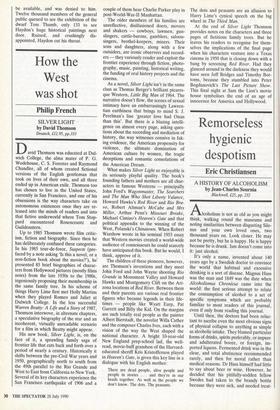How the West was shot
Philip French
SILVER LIGHT by David Thomson
Deutsch, £12.95, pp.333
David Thomson was educated at Dul- wich College, the alma mater of P. G. Wodehouse, C. S. Forester and Raymond Chandler, all of whom created fictional versions of the English gentleman that took on lives of their own, and all three ended up in American exile. Thomson too has chosen to live in the United States, currently in San Francisco, and one of his obsessions is the way characters take on autonomous existences once they are re- leased into the minds of readers and into that fictive underworld where Tom Stop- pard encountered Rosencrantz and Guildenstern.
Up to 1985 Thomson wrote film critic- ism, fiction and biography. Since then he has deliberately confused these categories. In his 1985 tour-de-force, Suspects (pre- faced by a note asking 'Is this a novel, or a non-fiction book about the movies?'), he presented 85 brief biographies of charac- ters from Hollywood pictures (mostly films noirs) from the late 1930s to the 1980s, ingeniously proposing their membership in the same family tree. In his scheme of things Harry Lime first met Holly Martins when they played Romeo and Juliet at Dulwich College. In the less successful Warren Beatty: A Life and a Story of 1987, Thomson interwove, in alternate chapters, a speculative biography of the star and an incoherent, virtually unreadable scenario for a film in which Beatty might appear.
His new book, Silver Light, is, on the face of it, a sprawling family saga of frontier life that cuts back and forth over a period of nearly a century. Historically it shifts between the pre-Civil War years and 1950, geographically north to south from the 49th parallel to the Rio Grande and West to East from California to New York. Several of its key characters experience the San Francisco earthquake of 1906 and a
couple of them hear Charlie Parker play in post-World-War-II Manhattan.
The older members of his families are unreflective, disillusioned doers, movers and shakers — cowboys, lawmen, gun- slingers, cattle-barons, gamblers, saloon- singers, brothel-keepers, miners. Their sons and daughters, along with a few outsiders, are ironic observers and record- ers — they variously render and exploit the frontier experience through fiction, photo- graphy, music, painting, historical writing, the funding of oral history projects and the cinema.
As a novel, Silver Light isn't in the same class as Thomas Berger's brilliant picares- que Western, Little Big Man of 1964. The narrative doesn't flow, the scenes of sexual intimacy have an embarrassingly Lawren- tian earthiness that brings to mind S. J. Perelman's line 'greater love had Onan than this'. But there is a blazing intelli- gence on almost every page, asking ques- tions about the recording and mediation of history, the way witnesses connive in fak- ing evidence, the American propensity for violence, the ultimate domination of American culture by women, the tragic deceptions and romantic consolations of the American Dream.
What makes Silver Light so enjoyable is its seriously playful quality. The book's founding fathers and mothers are all char- acters in famous Westerns — principally John Ford's Wagonmaster, The Searchers and The Man Who Shot Liberty Valance, Howard Hawks's Red River and Rio Bra- vo, Robert Altman's McCabe and Mrs Miller, Arthur Penn's Missouri Breaks, Michael Cimino's Heaven's Gate and that political appendix to the winning of the West, Polanski's Chinatown. When Robert Warshow wrote in his seminal 1953 essay that Western movies created a world-wide audience of connoisseurs he could scarcely have anticipated this book. But he would, I think, approve of it.
The children of these pioneers, however, are Thomson's inventions and they meet John Ford and John Wayne shooting Rio Grande in Monument Valley and Howard Hawks and Montgomery Clift on the Ari- zona locations of Red River. Between them and their parents are various real frontier figures who became legends in their life- times — people like Wyatt Earp, Pat Garrett and Billy the Kid. On the margins are such totally real people as the painter Albert Bierstadt, the novelist Willa Cather and the composer Charles Ives, each with a vision of the way the West shaped the national character. A bright 10-year-old New England prep-school lad, the well- read, movie-buff grandson of the Harvard- educated sheriff Kris Kristofferson played in Heaven's Gate, is given this key line in a dialogue with his English mother: There are dead people, alive people and people in stories . . . and they're in our heads together. As well as the people we don't know. The dots. The peasants.
The dots and peasants are an allusion to Harry Lime's cynical speech oh the big wheel in The Third Man.
At the end of Silver Light Thomson provides notes on the characters and three pages of fictitious family trees. But he leaves his readers to recognise for them- selves the implications of the final page when his characters venture into a Texas cinema in 1950 that is closing down with a bang by screening Red River. Had they glanced around in the darkness they would have seen Jeff Bridges and Timothy Bot- toms, because they stumbled into Peter Bogdanovich's The Last Picture Show. This final night at Sam the Lion's movie house symbolises the end of an age of innocence for America and Hollywood.


















































 Previous page
Previous page